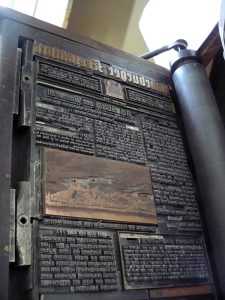In the Spotlight
Letterpress: Go on. Make an impression.
July, 2016
 Do you like to run your fingers over the pages of old books or letterpressed invitations, physically feeling the words, the punctuation? Are you lamenting the golden age of print, just a little? Don’t fret. A retro movement has begun, and presses and die-cast letters are being released from their 50-year exile by diehard print craftspeople. They’ve been cleaned, repaired and have started to speak once again.
Do you like to run your fingers over the pages of old books or letterpressed invitations, physically feeling the words, the punctuation? Are you lamenting the golden age of print, just a little? Don’t fret. A retro movement has begun, and presses and die-cast letters are being released from their 50-year exile by diehard print craftspeople. They’ve been cleaned, repaired and have started to speak once again.
In the broadest definition, letterpress is a process whereby a piece of paper is pressed onto an inked arrangement of letters, called a form, to produce a legible piece of printed text. Although many people assume that letterpress printing began with Johannes Gutenberg of Gutenberg Bible fame, it began much earlier in China, around AD 75. At that time, woodblock printing was used, and entire pages of text were carved into large wooden blocks. As the process was refined, single characters (rather than pages) were carved into blocks of type. It was around 1450 when Gutenberg came onto the scene. He cast each letter, comma and period from metal, tweaked the press machine and made letterpress the invention we think of today.
Are You a Kisser or a Biter?
If you want to make an impression, you have to have the right touch—literally. Too much pressure and you’ll punch words right through your paper and damage the type blocks. In this case, knowing your kisses from your bites comes in handy: a kiss is the term given to the lack of an impression on the paper—think of a brush of a person’s lips on your cheek—whereas a bite leaves an indentation in the paper from the type. Kisses are the desired impression if paper is being printed on both sides. Bites are better on heavier weighted paper and if the printing is only on one side. But we’re a tactile lot, and feeling the impressions left by the press in lovely cotton rag paper reminds us, if you will, that we haven’t lost touch with the past.
Impress Your Family & Friends
Once you’re a bit familiar with the art form, you can start thinking of ways to use it. Want a wedding invitation that’ll stand out? Design it to be made on a letterpress—and, yes, you can letterpress images. What about posters for a birthday party, a silent auction or a band’s upcoming performance? Yup. That can be done, too. You can even amalgamate scrapbooking and letterpress by making custom photo albums, family trees or books of family stories. You’re limited only by your imagination.
Ready to try? There are a few specialized print shops in the Edmonton area that will happily take care of projects for you. But why not take classes to get your fingers inked and see if you like doing it yourself? Be forewarned though. Once you’re hooked, you’ll see letterpress potential in everything. Before you know it, you’ll start talking in em-quads and slugs, and reading backwards will become second nature.
Go on. Make an impression! t8n
Tools & Terms
Composing stick: A ruler with a ledge where you place your type.
Em-quad: Metal spacers, size of a typical “m” used between words.
Leading: Strips of metal placed between lines of type. Six-point-sized leading is called a slug.
Type: Reversed metal letters and punctuation.
Letterpress Sources
Society of Northern Alberta Print Artists offers classes in letterpress.
www.snapartists.com
Canadian Bookbinders and Book Artists’ Guild support the book arts. cbbagalbertanorth.com
Letterpress Now: A DIY Guide to New & Old Printing Methods, by Jessica C. White. A book that gives the abc’s of letterpress, plus projects.











